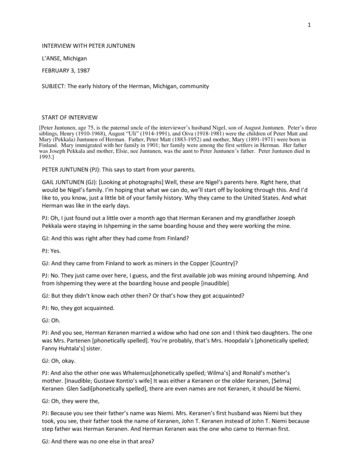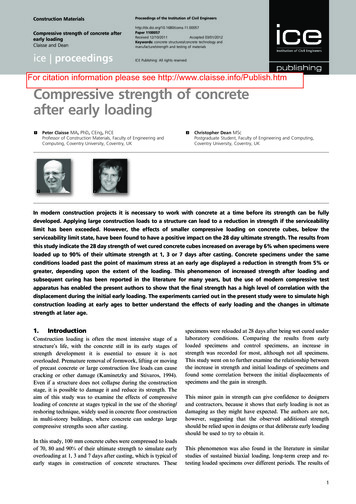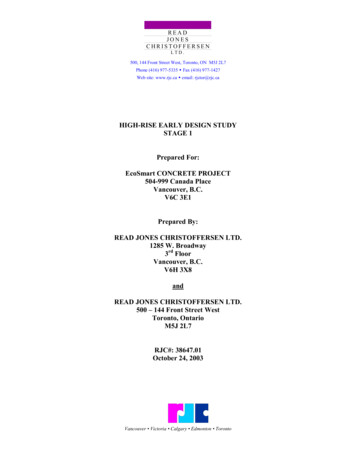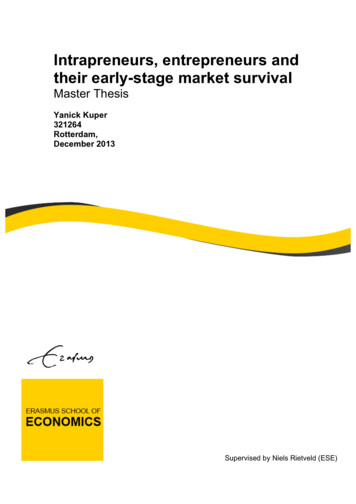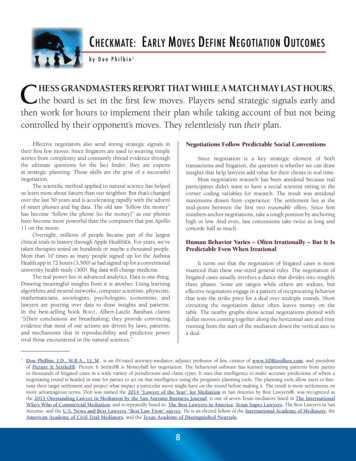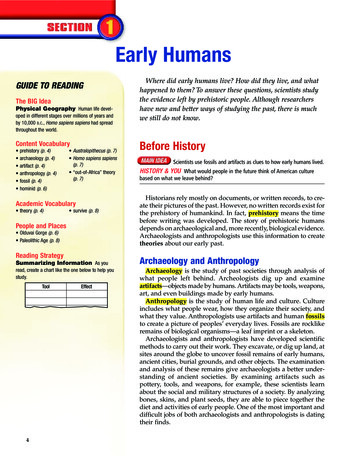
Transcription
Early HumansGUIDE TO READINGThe BIG IdeaPhysical Geography Human life developed in different stages over millions of years andby 10,000 B.C., Homo sapiens sapiens had spreadthroughout the world.Content Vocabulary prehistory (p. 4) archaeology (p. 4) artifact (p. 4) anthropology (p. 4) fossil (p. 4) hominid (p. 6) Australopithecus (p. 7) Homo sapiens sapiens(p. 7) “out-of-Africa” theory(p. 7)Academic Vocabulary theory (p. 4) survive (p. 8)People and Places Olduvai Gorge (p. 6) Paleolithic Age (p. 8)Reading StrategySummarizing Information As youread, create a chart like the one below to help youstudy.Tool4EffectWhere did early humans live? How did they live, and whathappened to them? To answer these questions, scientists studythe evidence left by prehistoric people. Although researchershave new and better ways of studying the past, there is muchwe still do not know.Before HistoryScientists use fossils and artifacts as clues to how early humans lived.HISTORY & YOU What would people in the future think of American culturebased on what we leave behind?Historians rely mostly on documents, or written records, to create their pictures of the past. However, no written records exist forthe prehistory of humankind. In fact, prehistory means the timebefore writing was developed. The story of prehistoric humansdepends on archaeological and, more recently, biological evidence.Archaeologists and anthropologists use this information to createtheories about our early past.Archaeology and AnthropologyArchaeology is the study of past societies through analysis ofwhat people left behind. Archeologists dig up and examineartifacts—objects made by humans. Artifacts may be tools, weapons,art, and even buildings made by early humans.Anthropology is the study of human life and culture. Cultureincludes what people wear, how they organize their society, andwhat they value. Anthropologists use artifacts and human fossilsto create a picture of peoples’ everyday lives. Fossils are rocklikeremains of biological organisms—a leaf imprint or a skeleton.Archaeologists and anthropologists have developed scientificmethods to carry out their work. They excavate, or dig up land, atsites around the globe to uncover fossil remains of early humans,ancient cities, burial grounds, and other objects. The examinationand analysis of these remains give archaeologists a better understanding of ancient societies. By examining artifacts such aspottery, tools, and weapons, for example, these scientists learnabout the social and military structures of a society. By analyzingbones, skins, and plant seeds, they are able to piece together thediet and activities of early people. One of the most important anddifficult jobs of both archaeologists and anthropologists is datingtheir finds.
20 W0 20 E40 EARCHAEOLOGICAL FINDS60 E1856: Johann Fuhlrott discoversHomo sapiens neanderthalensis1940: French childrenfind cave paintings01,000 kilometers01,000 milesAltamiraCaveMiller ASIA1958: James Mellaart discoversNeolithic farming village of Çatalhüyük.40 NÇatalhüyük1879: Marcelino Sanz de Sautuolaand his daughter find cave paintingsMediterranean Sea1994: Jean-Marie Chauvetdiscovers cave paintingsATLANTICOCEAN1974: Johanson teamdiscovers “Lucy”Re20 NDating Artifacts and FossilsDating human fossils and artifacts helpsscientists understand when and where thefirst humans lived.One method used to determine age isradiocarbon dating. All living thingsabsorb a small amount of radioactive carbon, or C-14, from the atmosphere. After aliving thing dies, it slowly loses C-14. Bymeasuring the amount left in an object, ascientist can figure its age. This method isaccurate for objects no more than about50,000 years old.For objects dating back to 200,000 yearsago, scientists can make relatively precisemeasurements using thermo-luminescence. This measures the light given off byelectrons trapped in the soil surroundingfossils and artifacts.eaSee StudentWorks Plusor glencoe.com.dS1. Location On which continent weremost of the hominid bones found?2. Place The “out-of-Africa” theorystates that hominids did notspread outside of Africa until theywere capable of tool use. How dothe sites depicted in Europe support this theory?Arabian SeaHadarNAFRICAW1960: Leakey teamdiscovers Homo habilis1978: Leakey team discovers“Laetoli footprints”ESEQUATOROlduvai Gorge0 INDIAN OCEANLaetoliMicroscopic and biological analyses oforganic remains—such as blood, hairs, andplant tissues left on tools and weapons—give scientists still more information. Suchanalyses have shown that blood moleculesmay survive millions of years. This recentscientific discovery is especially useful intelling us more about humans, their use oftools, and the animals they killed. Ancientdeoxyribonucleic acid (DNA) is providingnew information on human evolution. Theanalysis of plant remains on stone toolsyields evidence on the history of farming.All of these techniques give us insight intothe lives of early peoples. Reading Check Describing How doarchaeologists and anthropologists determine the agesof fossils and artifacts?CHAPTER 1The First Humans5
(l) Topham/The Image Works, (r) Robert Campbell/CORBIS SYGMAEarly DevelopmentUsing remains and technology, scientists identify important stages in human development.HISTORY & YOU How did humans change? ReadLouis and Mary Leakey spent most oftheir lives searching for clues about earlyhuman life. They made a dramatic discoveryof a skeleton at Olduvai Gorge in EastAfrica. According to their son:about the early stages of human development.PRIMARY SOURCEIn recent decades, modern science hasproduced a clearer picture of how earlyhumans developed. Pieces of the puzzleare still missing, however. When a newskull or skeleton is unearthed, scientistsmay find that they have to revise theirideas about prehistoric human life.Hominids to Homo SapiensWhat is a hominid? A hominid was ahumanlike creature that walked upright.The earliest hominids lived in Africa fourmillion years ago. They existed for millionsof years, slowly changing over time.“My father was ill that morning, so my motherset out alone . . . but found very little until just beforenoon, when she noticed a scrap of enormouslythick bone protruding from beneath the surface.She instantly realized that it was part of a hominidskull—and that two teeth were embedded in therock just above it. Elated, she drove back to campto tell my father Louis. As he remembered it, sherushed in crying, ‘I’ve got him! I’ve got him! I’vegot him!’”—Richard Leakey, TIME, July 17, 1959Leakey’s discovery of a hominid in 1959was the oldest at that time—about 1.8 millionyears old.Louis LeakeyMary LeakeyRichard Leakey Louise Leakey Meave Leakey1903–19721913–1996 ists study early human society. For threegenerations, beginning with the husband and wife team ofLouis and Mary, the Leakeys have searched for early humanremains in Africa.Born in Kenya, Louis discovered some stone tools and aninterest in prehistory. In the 1930’s, Louis and Mary beganlooking for evidence of early humans at Olduvai Gorge. Mary iscredited with discovering Proconsul africanus in 1948, Australopithecus boisei in 1959, Homo habilis in 1960, and an 89-footlong trail of early human footprints called the “Laetoli footprints”in 1979. What do the Leakeys’ finds illustrate about whereearly human life began?1972–present1942–present PaleoanthropologistsRichard, a son of Louis and Mary, found his first fossil at agesix. Meave, a zoologist, joined Richard’s expedition in 1969.Richard and Meave focused their search at Koobi Fora, near LakeTurkana in Kenya. Over a thirty-year period, this Leakey teammade 200 significant fossil finds.Meave and Louise Leakey were named National GeographicSociety’s explorers-in-residence in 2002. The Leakey mother anddaughter paleontologists found a 3.5 million-year-old skull nearTurkana. Why were the Leakeys’ fossil finds significant?
For decades, scientists assumed theseearliest of upright creatures must alsohave used tools. In 1974, Donald Johansonchallenged this theory when his teamfound a new skeleton in Ethiopia. Johansonnicknamed the female skeleton “Lucy”and suggested that she was the commonancestor for several types of early humanlife. Scientists called this type of hominidAustralopithecus (aw STRAY loh PIH thuh CUS), or “southern ape.” It flourished in eastern and southern Africa.In a 1991 interview, Johanson explainedwhy “Lucy” changed the ideas of manyscientists about hominids that walkedupright:PRIMARY SOURCE“People felt that there were a number ofevolutionary changes, which all went together.That our ancestors stood up to free their hands sothat they could make and use stone tools. In orderto make and use stone tools, they had to havelarge brains . . . Here comes Lucy, about 3.5 millionyears old . . . very small brain, . . . and we havenever found any stone tool, stone artifacts,associated with her species. Yet she is walkingupright. So it appears that . . . walking on twolegs, precedes by perhaps as much as a millionand a half years, the manufacture of stone toolsand the expansion of the brain.”—Donald Johanson, 1991 interviewFrom 2.5 to 1.6 million years ago, a moreadvanced hominid developed with a somewhat larger brain. This hominid wasnamed Homo habilis, meaning “handyhuman.” Homo habilis may have used stonetools. The earliest remains of this hominidwere discovered near Olduvai Gorge.Another hominid, Homo erectus, “uprighthuman,” existed from 1.8 million to 100,000years ago. Although other hominidswalked on two legs, Homo erectus had armsand legs in modern human proportion.Remains in Asia show that Homo erectuswas probably the first hominid to leaveAfrica.Around 200,000 years ago, Homo sapiensemerged. Homo sapiens, “wise human,”showed rapid brain growth and masteredfire. Two kinds of early humans descendedfrom Homo sapiens: Neanderthals and Homosapiens sapiens. In the Neanderthal, a valleyin Germany, the earliest remains of Neanderthals, or Neandertals, were found. Theyprobably lived between 100,000 b.c. and30,000 b.c. Other Neanderthal remainshave been found in Europe and Turkey.Besides using many kinds of stone tools,European Neanderthals made theirclothes from animal skins. Neanderthalsseem to be the first early people to burytheir dead. According to some scholars,burying the dead indicates a belief in anafterlife.Homo Sapiens SapiensThe second group descended from Homosapiens is Homo sapiens sapiens, meaning“wise, wise human.” These are the first tohave an anatomy similar to people today.Physical evidence suggests that Homosapiens sapiens appeared in Africa between150,000 and 200,000 years ago. They probably spread out of Africa to other parts of theworld about 100,000 years ago, replacingpopulations of earlier hominids in Europeand Asia. This is referred to as the “out-ofAfrica” theory (or replacement theory).Another theory, the multiregional model,states that the development from earlierhominids to anatomically modern humansoccurred in different locations in Africa,Asia, and Europe. The timing and reasonsfor early human migrations are still debatedamong scholars.By 30,000 b.c., Homo sapiens sapiens hadreplaced the Neanderthals. The Neanderthals died out, possibly as a result ofconflicts with Homo sapiens sapiens. Thespread of these first modern humans was aslow process. Over many thousands ofyears, Homo sapiens sapiens spread over theglobe as they searched for food and newhunting grounds. In a whole generation,they may have moved only two to threemiles. Over hundreds of thousands ofyears, this was enough to populate theworld. Today, all humans, whether theyare Europeans, Australian Aborigines(A buh RIJ nees), or Africans, belong tothe same subgroup of human beings. Reading Check Summarizing Identify anddescribe all the important stages in early humandevelopment.CHAPTER 1The First Humans7
The Paleolithic AgeEarly humans used fire, made tools,and adapted to survive.HISTORY & YOU Could you live in the wild withonly tools you made? Read how early humans managed to survive.One of the basic distinguishing featuresof the human species is the ability to maketools. The term Paleolithic Age is used todesignate the early period of humanhistory (approximately 2,500,000 to 10,000b.c.) in which humans used simple stonetools. Paleolithic is Greek for “old stone,”and the Paleolithic Age is sometimes calledthe Old Stone Age.Hunting and GatheringFor hundreds of thousands of years,humans relied on hunting and gatheringfor their daily food. Paleolithic peopleshad a close relationship with their environment. They came to know what animals tohunt and what plants to eat. They gatheredwild nuts, berries, fruits, wild grains, andgreen plants. Around the world, theyhunted and ate various animals, includingbuffalo, horses, bison, and reindeer. Incoastal areas, fish and shellfish provided arich source of food.The Paleolithic Way of LifeEarly humans were able to sustain themselves through the use of stone tools. Tomake such tools, early people used veryhard stones, such as flint. They used onestone to chip away parts of another, creating an edge. Hand axes of various kinds—pointed tools with one or more cuttingedges—were the most common. Hand axeseventually were set in wooden handles,making them easier to use. By attachingwooden poles to spear points and hardening the tips in fire, humans created spearsto kill large animals.Over the years, Paleolithic hunters developed better tools. The invention of the spear,and later the bow and arrow, made huntingmuch easier. Harpoons and fishhooks madeof bone increased the catch of fish.8SECTION 1Early HumansEarly humans used sharp-edged tools tocut up plants, dig up roots, and cut branchesto build simple shelters. Scraping tools wereused to clean animal hides for clothing andshelter. By the end of the Paleolithic period,there is evidence of such refined tools asbone needles. These needles could be usedfor making nets and baskets and even sewing hides together for clothing.Because Paleolithic people were huntersand gatherers, they had to follow animalmigrations and vegetation cycles. Paleolithic humans were nomads—people whomove from place to place to survive.Archaeologists and anthropologists thinkthese nomads probably lived in smallgroups of twenty or thirty. Huntingdepended on careful observation of animalbehavior patterns and demanded groupcooperation for success.The Roles of Men and WomenThe main job of Paleolithic peoples wasfinding enough to eat. Both men and womenwere responsible for finding the foodneeded for survival. Paleolithic parentspassed on their practices, skills, and toolsto their children to ensure the survival oflater generations.Since women bore and raised children,they probably stayed closer to camp. Theyplayed an important role in acquiringfood by gathering berries, nuts, roots,and grains. Women taught the childrenwhich foods were edible. They trappedsmall animals and kept the camp safe.In the constant search for food, men hadto travel far from camp to hunt herds oflarge animals. What the women caughtand gathered had to feed the group if therewas no game. Because both men andwomen were responsible for finding andacquiring the food needed to sustain life,many scientists believe there was equalitybetween them. It is likely that both menand women made decisions that affectedthe activities of the Paleolithic group.Adapting to SurviveGroups of Paleolithic people, especiallythose groups who lived in cold climates,found shelter in natural caves. Over a
period of time, people created new typesof shelter as well. Perhaps most commonwas a simple structure made of wood polesor sticks covered with animal hides. Inplaces where wood was scarce, they mightuse the large bones of mammoths to buildframes that were then covered by animalhides. The systematic use of fire made itpossible to provide a source of both lightand heat within both the caves and thehandmade structures in which they lived.Use of FireAnother important result from themigration of early hominids was the use offire. As early hominids moved from thetropics into colder regions, they needed toadjust to new climate conditions. Inresponse, Homo erectus first learned tomake fires. Archaeologists have discovered the piled remains of ashes in cavesthat prove that Paleolithic people used firesystematically as long ago as 500,000 years.Field Archaeology: How We Learn about the Spread of Early HumansArchaeologists use scientific methodsto learn more about prehistory. Thetechniques and materials used on a“dig” combine older tools andmodern technology.First archaeologists searchcomputer databases, maps, aerialphotos, and satellite images to find apromising site. At the site, the team willrecord the exact location with a globalpositioning device. Then using surveyequipment, they map the area and set up agrid to pinpoint the location and depths ofthe finds. Workers still use trowels andbrushes to unearth artifacts.Once an object is found, archaeologistsrecord it in their field notes. Then they clean,label, photograph, and enter the find on adatabase. A rough “dating” is made usingstratigraphy, indicating age by the soil layerit was found in. Other tests—radiocarbondating, potassium-argon dating, DNA, thermoluminescence, and dendrochronology—are done in a lab.1. Explaining Why does it take archaeologists many years to exavate a site?2. Drawing Conclusions How doesarchaeology provide information formaps like the one on page 5?At an excavation of an Inca cemetery near Lima, Peru,a man brushes dirt from a skull with hair still intact.(l) Ira Block/National Geographic/Getty Images, (tr) photolibrary.com/Index Open, (br) Cordelia Molloy/Photo ResearchersLaptops makethe dig easier.Hand-heldGPS (GlobalPositioningSystem)
BayofBiscayChauvet CaveLascauxCavesFRANCEAltamiraCavePaleolithic artists drew dangerousmammoths, rhinos, cave bears, and cavelions, but rarely depicted themselves.ChauvetCaveSPAINChauvet’s constant temperature of56º F with 99 percent humidityhelped preserve the paintings.Although people never livedthere, Chauvet contains remnantsof fires, used to produce charcoalfor drawing.Around 35,000 years ago, Ice Ageartists painted images in caves. This20-foot (6-m)-long “Panel of Horses”was found in Chauvet Cave insouthern France.1. Analyzing What does the “Panelof Horses” depict?2. Comparing What similarities doyou see between animals in thecave art and those of today?At a Homo erectus site in northern China,remnants of hearths, ashes, charcoal, andcharred bones have been dated to 400,000years ago.Fire not only gave warmth, but kept wildanimals away from the campsite. Armedwith spears, hunters used fire to flush outwild pigs for the kill. People gatheredaround the fire to trade stories and to cook.Cooked food tasted better, lasted longer,and was easier to chew and digest (in thecase of some plants, such as wild grains),so it seems likely that nutrition improved.Scholars believe that the discovery of ameans for starting fires occurred10Jean ClottesSECTION 1Early Humansindependently throughout the world, indifferent places at different times. Archaeologists lack concrete evidence on howearly peoples started fires. They have beenable to examine the methods used by traditional peoples. On that basis, archaeologists deduce that the earliest humans usedfriction to start fires.Eventually, some Paleolithic peoplesdeveloped sturdy, drill-like woodendevices to start fires. Other early humansdiscovered that a certain stone, ironpyrites, gave off a spark when struckagainst a rock and that spark could ignitedry grass or leaves.
The Ice AgesHaving fire to create a source of heat was especiallyimportant when Ice Age conditions descended on thePaleolithic world. The most recent Ice Age began about100,000 b.c. and ended in about 8000 b.c. During this time,sheets of thick ice covered large parts of Europe, Asia, andNorth America. As sea levels went down, people migratedacross land bridges that had not existed before.Ice Age conditions posed a serious threat to human life,and the ability to adapt was crucial to human survival.The use of fire, for example, reminds us that early humanssometimes adapted not by changing themselves to betterfit their environment but by changing the environment.Vocabulary1. Explain the significance of: prehistory,archaeology, artifact, anthropology, fossil,hominid, Olduvai Gorge, Australopithecus,Homo sapiens sapiens, “out-of-Africa”theory, Paleolithic Age.Main Ideas2. Discuss what kinds of materialsarchaeologists use to study prehistory.Creating ArtThe importance of art to human life is basic. Art existedeven in prehistory among the hunters and gatherers of thePaleolithic Age. In 1940, a bad storm near Lascaux(la SKOH) in southern France uprooted a large tree,revealing a cave. French children playing nearby soonfound the cave and the paintings inside. Many of thesepaintings had deteriorated, but scientists used specialtools to determine what is being depicted, such as horses,bulls, and stags.Another famous discovery was made in Spain in 1879when a little girl wandered into a cave on her grandfather’s farm near Altamira. Like many other caves coveredwith Paleolithic art, the cave near Altamira shows evidence that the paintings may have been created over aspan of time, not all at once. Scientists can date the artbased on pigments from the paintings.In 1994, Jean-Marie Chauvet and his friends discoveredpaintings in southern France. Carbon dating showedworks at Chauvet Cave were nearly twice as old as thoseat Lascaux and Altamira, but the drawings were moreadvanced. Scholars had assumed the opposite—that theearliest art would be crude and gradually would becomemore detailed.Using stone lamps filled with animal fat to light thecaves, early artists painted with fingers, twigs, and evenblew paint through hollow reeds. They mixed mineralores with animal fat to make red, yellow, and black paint.A variety of realistically painted animals cover the caves.Few humans appear in these paintings, and when they doappear, they are drawn as sticklike figures. This has ledsome scholars to think the work was done for a magical orreligious ritual to bring success in hunting. Others believethe paintings were made simply to please the eye. Recentdiscoveries of art by early humans show that prehistoric art existed in other areas of the world. Reading CheckIdentifying What are two importantinnovations of Paleolithic peoples?3. Explain what the caves of Lascauxsuggest about early human society.4. Create a diagram like the one shownbelow to compare and contrastaustralopithecus and Neanderthal.AustralopithecusNeanderthalCritical Thinking5. The BIG Idea Explaining Explain thedifference between the “out-of-Africa” andmultiregional theories.6. Comparing Discuss the difference betweenthe roles of Paleolithic men and women.7. Analyzing Visuals Examine the cavepaintings shown on page 10. What do theytell you about human/animal interactionsduring the Paleolithic Age?Writing About History8. Descriptive Writing Imagine you are partof an archaeological team at a recentlydiscovered site, keeping a daily journal.Describe the conditions of the site, the sortsof artifacts you are finding, and what youhope to find based on the evidence so far.Read magazine articles or books in a libraryor on the Web to help you with this project.(ISTORY/.,).%For help with the concepts in this section of Glencoe WorldHistory, go to glencoe.com and click Study Central.11
By 30,000 b.c., Homo sapiens sapiens had replaced the Neanderthals. The Neander-thals died out, possibly as a result of conflicts with Homo sapiens sapiens. The spread of these first modern humans was a slow process. Over many thousands of years, Homo sapiens sapiens spread over the
